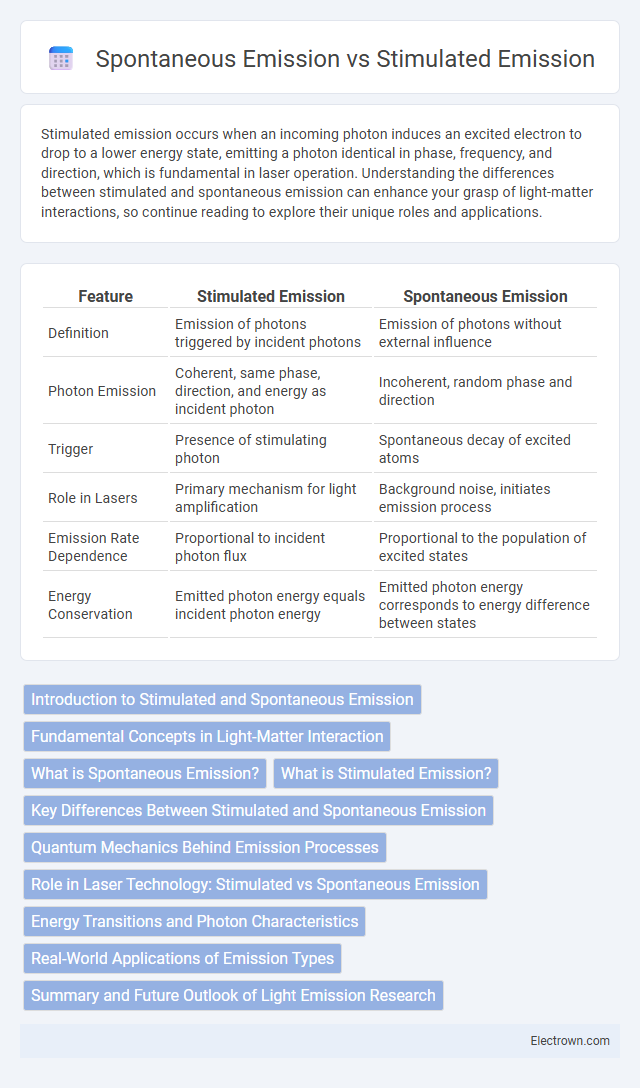Stimulated emission occurs when an incoming photon induces an excited electron to drop to a lower energy state, emitting a photon identical in phase, frequency, and direction, which is fundamental in laser operation. Understanding the differences between stimulated and spontaneous emission can enhance your grasp of light-matter interactions, so continue reading to explore their unique roles and applications.
Table of Comparison
| Feature | Stimulated Emission | Spontaneous Emission |
|---|---|---|
| Definition | Emission of photons triggered by incident photons | Emission of photons without external influence |
| Photon Emission | Coherent, same phase, direction, and energy as incident photon | Incoherent, random phase and direction |
| Trigger | Presence of stimulating photon | Spontaneous decay of excited atoms |
| Role in Lasers | Primary mechanism for light amplification | Background noise, initiates emission process |
| Emission Rate Dependence | Proportional to incident photon flux | Proportional to the population of excited states |
| Energy Conservation | Emitted photon energy equals incident photon energy | Emitted photon energy corresponds to energy difference between states |
Introduction to Stimulated and Spontaneous Emission
Stimulated emission occurs when an incoming photon induces an excited electron to drop to a lower energy state, releasing a photon coherent with the stimulating one, which is fundamental to laser operation. Spontaneous emission happens when an excited electron independently returns to a lower energy level, emitting a photon with random phase and direction, essential in fluorescence and natural light emission. Both processes involve electron transitions between atomic or molecular energy states but differ in photon emission control and coherence.
Fundamental Concepts in Light-Matter Interaction
Stimulated emission occurs when an incident photon induces an excited electron to drop to a lower energy state, emitting a photon coherent in phase, frequency, and direction with the stimulating photon. In contrast, spontaneous emission arises from random decay of an excited electron to a lower energy level without external prompting, producing photons with random phase and direction. Both processes critically underpin laser operation and quantum optics by governing photon generation mechanisms and light amplification through light-matter interaction.
What is Spontaneous Emission?
Spontaneous emission is the process by which an excited atom or molecule returns to a lower energy state by emitting a photon without external influence. This emission occurs randomly and isotropically, with a photon wavelength corresponding to the energy difference between the two states. In contrast to stimulated emission, spontaneous emission does not require an incident photon to trigger photon release, making it a fundamental mechanism in fluorescence and phosphorescence.
What is Stimulated Emission?
Stimulated emission occurs when an incoming photon induces an excited electron to drop to a lower energy level, releasing a second photon identical in phase, frequency, and direction to the incoming photon. This process is fundamental to laser operation, enabling coherent light amplification. Unlike spontaneous emission, which emits photons randomly, stimulated emission produces highly organized and amplifiable light waves.
Key Differences Between Stimulated and Spontaneous Emission
Stimulated emission occurs when an incoming photon of a specific energy prompts an excited electron to drop to a lower energy level, emitting a photon identical in phase, frequency, and direction, crucial for laser operation. Spontaneous emission happens randomly as an excited electron returns to a lower energy state without external influence, releasing photons in random directions with varying phases. The key difference lies in stimulated emission's coherent, amplified photon production, whereas spontaneous emission generates incoherent, uncorrelated photons.
Quantum Mechanics Behind Emission Processes
Stimulated emission and spontaneous emission are fundamental quantum mechanical processes describing photon emission from excited atoms or molecules. Spontaneous emission occurs randomly as an excited electron transitions to a lower energy state, emitting a photon with a probability governed by time-dependent perturbation theory. Stimulated emission involves an incident photon inducing an excited electron to emit a coherent photon of identical phase, frequency, and direction, explained by Einstein's coefficients and the quantum theory of radiation.
Role in Laser Technology: Stimulated vs Spontaneous Emission
Stimulated emission is the fundamental mechanism behind laser technology, where incoming photons induce excited electrons to emit identical photons, resulting in coherent light amplification critical for laser operation. In contrast, spontaneous emission occurs randomly, producing incoherent light that does not contribute to the controlled beam formation needed in lasers. Your understanding of laser efficiency hinges on maximizing stimulated emission while minimizing spontaneous emission within the gain medium.
Energy Transitions and Photon Characteristics
Stimulated emission occurs when an incoming photon induces an excited electron to drop to a lower energy level, emitting a photon identical in phase, frequency, and direction to the stimulating photon, enabling coherent light amplification seen in lasers. Spontaneous emission results from an excited electron spontaneously transitioning to a lower energy state, emitting a photon with random phase, frequency within a spectral linewidth, and direction, producing incoherent light typical of fluorescence. The precise energy difference between atomic or molecular energy levels governs the photon's wavelength in both processes, but stimulated emission's photon coherence is critical for optical amplification technologies.
Real-World Applications of Emission Types
Stimulated emission is the fundamental process behind laser technology, enabling coherent light production essential for optical communication, medical surgeries, and precision manufacturing. Spontaneous emission, while less controlled, plays a critical role in fluorescence-based imaging techniques, LED lighting, and natural light sources. Understanding these emission mechanisms enhances the development of photonic devices and advances fields such as quantum computing and spectroscopy.
Summary and Future Outlook of Light Emission Research
Stimulated emission offers precise control over photon generation, forming the basis of laser technology, while spontaneous emission occurs randomly, producing incoherent light essential for diverse optical applications. Advances in nanophotonics and quantum materials are driving future research towards enhancing emission efficiency and coherence at the nanoscale. Your exploration of light emission technologies will benefit from these innovations, promising breakthroughs in optoelectronics and quantum communication.
stimulated emission vs spontaneous emission Infographic

 electrown.com
electrown.com